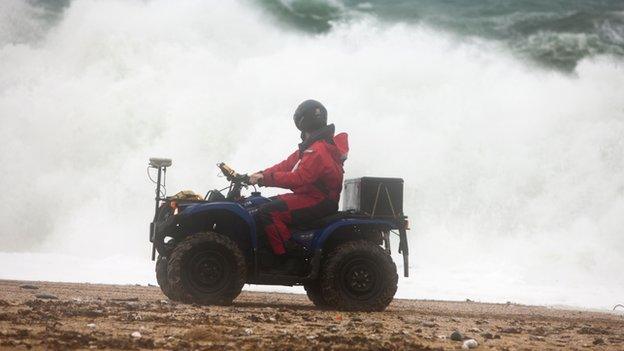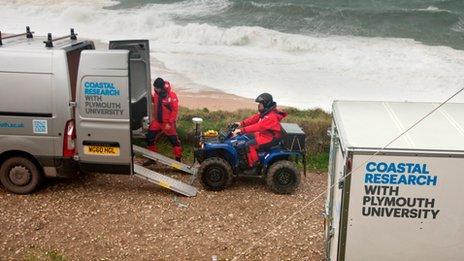Plymouth 'storm chasers' defend UK coastline
- Published

Researchers are hoping to find the most cost-effective way to defend the coast against the sea
They call themselves the "storm chasers".
But they are not the Hollywood-style whirlwind worriers of the 1996 film Twister.
They are Plymouth University's Rapid Coastal Response Unit (RCRU) - ready to visit the beach at the drop of an extreme weather forecast.
They aim to record and assess the damage to coastal defences, in response to predictions of sea level rises and climate change.
The idea for the RCRU came from the university's School of Marine Science and Engineering, which wanted a fast response to extreme weather.
Professor Gerd Masselink said: "It usually takes three to four days to put our kit in place, by which time the storm could have passed.
"We needed to change the way we worked."
Two years ago, his team put a proposal to the Engineering and Physical Sciences Research Council and has now won a £550,000 grant to study coastal erosion over three years.
A van, kitted out with cameras, a laser, GPS and a quad bike is ready to go anywhere in the UK that a storm has been forecast.
The RCRU has a squad of about 15 lecturers and students, including a number of surfers for whom studying waves is something they do every day.
Professor Paul Russell, twice European surfing champion, said: "Measuring beach change during storms remains very challenging, but is absolutely necessary to understand better how coastlines respond to extremely large waves and high water levels."
In November, the team headed to Porthleven in Cornwall where waves of (23ft) 7m were predicted.
A 9ft-high scaffolding tower holds two video cameras, while another holds a laser that sweeps the beach and the waves, recording movement of the gravel, a vital defence against the sea.
The RCRU is thought to be the only unit of its kind in Europe.
Professor Masselink accepts we will never be able to "turn back the tide, King Canute-style".
"But, with proper information we could make our sea defences the most efficient and cost-effective," he said.
For instance, the team's research has raised questions about the efficiency of bulldozing gravel up a beach to bolster defences.
Prof Masselink said: "In the past when coastal managers have found a gravel barrier is vulnerable, they will get a couple of bulldozers and shove it to the top.
"That can make it more vulnerable because it makes it a really thin high barrier and you have weakened the structure.
"A proper computer model will help you manage these things."
The RCRU has also been involved with Liverpool University in assessing sea defences around Sizewell and Sellafield nuclear power stations, "ensuring the long-term viability of the sites".
With the information about exact wave heights, money can be saved by not over-engineering solutions.
"Coastal protection is very expensive," said Prof Masselink. "The lower a sea wall, the cheaper it is.
"What we are about is better coastal management."
The first storm of the season has successfully been chased, in Porthleven.
Average wave heights peaked at nearly 18ft (5.4m), with the biggest wave recorded at an incredible 30ft (10.2m).
Until the next big storm, the team goes back to scanning the weather charts.

The team is equipped with a quad bike, cameras and a laser to monitor storms
- Published3 December 2012
- Published29 November 2012
- Published24 October 2012
- Published12 October 2011
- Published10 July 2012
- Published2 July 2010